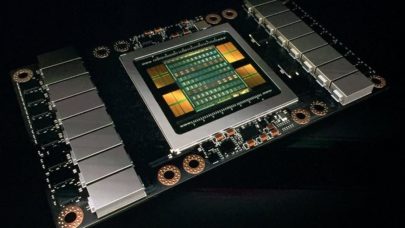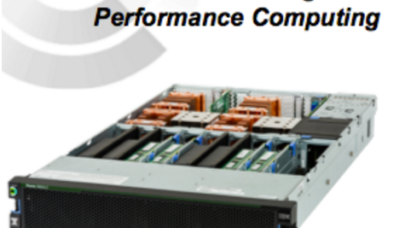
Nvidia’s Mammoth Volta GPU Aims High for AI, HPC
May 10, 2017
At Nvidia's GPU Technology Conference (GTC17) in San Jose, Calif., this morning, CEO Jensen Huang announced the company's much-anticipated Volta architecture a Read more…

Power8 with NVLink Coming to the Nimbix Cloud
October 6, 2016
Starting later this month, HPC professionals and data scientists wishing to try out NVLink'd Nvidia Pascal P100 GPUs won't have to spend upwards of $100,000 on NVIDIA's DGX-1 server or fork over about half that for IBM's Power8 server with NVLink and four Pascal GPUs. Soon they'll be able to get the power of Pascal in a public cloud. Read more…

NVIDIA Adds ‘Parker’ CPU to ‘Brain of Autonomous Vehicles’
August 25, 2016
NVIDIA's autonomous vehicle strategy took a step forward this week with the announcement of a new mobile CPU, called “Parker,” offered to automakers as a si Read more…

Why 2016 Is the Most Important Year in HPC in Over Two Decades
August 23, 2016
In 1994, two NASA employees connected 16 commodity workstations together using a standard Ethernet LAN and installed open-source message passing software that a Read more…

Europe’s Fastest Supercomputer to Get Pascal GPU Upgrade
April 6, 2016
Already Europe’s fastest supercomputer at 7.8 petaflops, the Piz Daint (hybrid CPU/GPU Cray XC30) at the Swiss National Computing Center (CSCS) will double its performance with a massive upgrade that involves switching to NVIDIA’s newest Pascal GPU architecture and merging with Piz Dora (Cray XC40), a smaller CPU-based machine. The announcement was made at GTC16... Read more…

NVIDIA Unleashes Monster Pascal GPU Card at GTC16
April 5, 2016
Tuesday at the seventh-annual GPU Technology Conference (GTC) in San Jose, Calif., NVIDIA revealed its first Pascal-architecture based GPU card, the P100, calling it "the most advanced accelerator ever built." The P100 is based on the NVIDIA Pascal GP100 GPU... Read more…

NVIDIA Pascal GPUs Coming to Automotive ‘Supercomputer’
January 6, 2016
It's no secret that NVIDIA is eager to take elements of its successful GPGPU ecosystem developed in partnership with the HPC community and transfer these to Read more…

- Click Here for More Headlines

Whitepaper
Transforming Industrial and Automotive Manufacturing
In this era, expansion in digital infrastructure capacity is inevitable. Parallel to this, climate change consciousness is also rising, making sustainability a mandatory part of the organization’s functioning. As computing workloads such as AI and HPC continue to surge, so does the energy consumption, posing environmental woes. IT departments within organizations have a crucial role in combating this challenge. They can significantly drive sustainable practices by influencing newer technologies and process adoption that aid in mitigating the effects of climate change.
While buying more sustainable IT solutions is an option, partnering with IT solutions providers, such and Lenovo and Intel, who are committed to sustainability and aiding customers in executing sustainability strategies is likely to be more impactful.
Learn how Lenovo and Intel, through their partnership, are strongly positioned to address this need with their innovations driving energy efficiency and environmental stewardship.
Download Now
Sponsored by Lenovo
Whitepaper
How Direct Liquid Cooling Improves Data Center Energy Efficiency
Data centers are experiencing increasing power consumption, space constraints and cooling demands due to the unprecedented computing power required by today’s chips and servers. HVAC cooling systems consume approximately 40% of a data center’s electricity. These systems traditionally use air conditioning, air handling and fans to cool the data center facility and IT equipment, ultimately resulting in high energy consumption and high carbon emissions. Data centers are moving to direct liquid cooled (DLC) systems to improve cooling efficiency thus lowering their PUE, operating expenses (OPEX) and carbon footprint.
This paper describes how CoolIT Systems (CoolIT) meets the need for improved energy efficiency in data centers and includes case studies that show how CoolIT’s DLC solutions improve energy efficiency, increase rack density, lower OPEX, and enable sustainability programs. CoolIT is the global market and innovation leader in scalable DLC solutions for the world’s most demanding computing environments. CoolIT’s end-to-end solutions meet the rising demand in cooling and the rising demand for energy efficiency.
Download Now
Sponsored by CoolIT
Advanced Scale Career Development & Workforce Enhancement Center
Featured Advanced Scale Jobs:
HPCwire Resource Library
HPCwire Product Showcase
© 2024 HPCwire. All Rights Reserved. A Tabor Communications Publication
HPCwire is a registered trademark of Tabor Communications, Inc. Use of this site is governed by our Terms of Use and Privacy Policy.
Reproduction in whole or in part in any form or medium without express written permission of Tabor Communications, Inc. is prohibited.
























